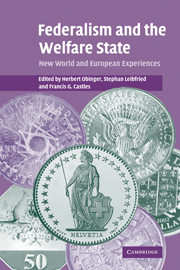Book contents
- Frontmatter
- Contents
- List of figures
- List of tables
- List of contributors
- Preface
- Note on illustrations
- 1 Introduction: federalism and the welfare state
- Part 1 New World experiences
- 2 Australia: federal constraints and institutional innovations
- 3 Canada: nation-building in a federal welfare state
- 4 The United States: federalism and its counter-factuals
- Part 2 European experiences
- Part 3 Conclusion
- Index
2 - Australia: federal constraints and institutional innovations
Published online by Cambridge University Press: 22 September 2009
- Frontmatter
- Contents
- List of figures
- List of tables
- List of contributors
- Preface
- Note on illustrations
- 1 Introduction: federalism and the welfare state
- Part 1 New World experiences
- 2 Australia: federal constraints and institutional innovations
- 3 Canada: nation-building in a federal welfare state
- 4 The United States: federalism and its counter-factuals
- Part 2 European experiences
- Part 3 Conclusion
- Index
Summary
Introduction
Considerations of systematic coverage apart, there are a number of reasons why a comparative study of the impact of federalism on the development of the welfare state might wish to dwell on the Australian case. Perhaps the most important is that the Australian case seems to exemplify all of the key hypotheses identified in the theoretical literature linking these phenomena. If the basic hypothesis linking federalism to the ‘old politics’ of the welfare state is that federal institutions hinder welfare state expansion, Australia appears to fit the bill rather well. With the exception of a decade or so of radical experimentation immediately after federation, the story of the Australian welfare state in the first half of the twentieth century is one of the late adoption of schemes increasingly common elsewhere and, after World War Two, of levels of expenditure that are consistently towards the bottom of international league tables.
Since the early 1980s, however, things appear to have changed. In the ‘silver age’ of welfare state development, Australia has been hailed as one of the few OECD countries to combine measurable success in economic performance with a significant improvement in welfare provision. On the surface, this seems to fit with the ‘new politics’ notion of federal institutions exercising a ‘ratchet effect’ on expenditure development, making it difficult for political forces opposed to statist intervention to obtain the leverage required to reverse existing policies.
- Type
- Chapter
- Information
- Federalism and the Welfare StateNew World and European Experiences, pp. 51 - 88Publisher: Cambridge University PressPrint publication year: 2005
- 6
- Cited by



